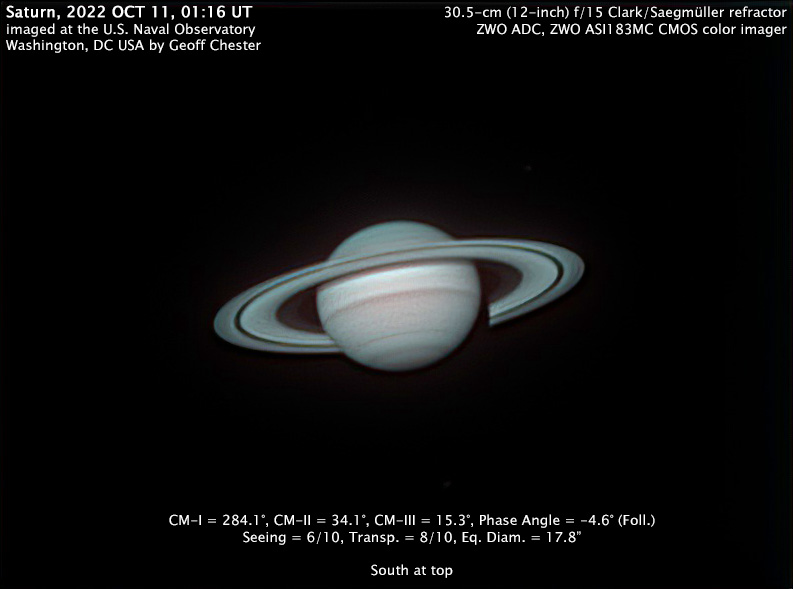
Saturn, imaged 2022 October 11, 01:16 UT at the U.S. Naval Observatory
with the 30.5-cm (12-inch) f/15 Clark/Saegmüller refractor and a ZWO ASI183MC CMOS color imager.
The Moon brightens the evening skies this week as she waxes to a robust full phase that will occur on the 8th at 6:02 am Eastern Standard Time. Yes, it’s time once again to set your clocks back by an hour. More on that below. November’s Full Moon is popularly called the Beaver Moon, a name that derives from Native Americans’ observations that beavers are hurriedly working on their dams and lodges in anticipation of the coming winter. Other names for November’s Full Moon include the Frost Moon, Trading Moon, or White Oak Moon. Luna starts the week a few degrees to the south of baleful Saturn in the early evening of the 1st. On the 4th Luna passes just three degrees below bright Jupiter.
While I doubt that more than a few people will be awake at 2:00 am local time on the morning of the 6th, that is nonetheless the official time to set your clocks back by one hour. The idea of adjusting clocks to reflect the seasons has always been controversial, and it has fallen in and out of favor since its inception in the U.S. in 1918. Originally designed to benefit munitions factories in World War I, it proved to be so unpopular that the law was repealed in 1919. It then became a topic for state and local officials to implement until 1942, when President Roosevelt implemented “War Time” for the duration of World War II. Congress restored Daylight Time to the Federal level in 1966, amending the start and stop dates in 1986 and 2005. In recent years there has been much debate about putting the Nation on permanent Daylight or Standard Time, but nothing will happen until Congress makes a decision. That may take awhile!
This year the Beaver Moon has a twist as it undergoes the second total lunar eclipse for the year. Unlike the eclipse that occurred back in May, those of us who live east of the Mississippi River won’t see the full duration of the event. Along the East Coast, we’ll see the initial partial phases as well as the total phase, but the Moon will be low in the west and will set shortly after the end of totality. If you want to see the eclipse in its entirety travel to the West Coast or, better yet, Hawai’i! Here in the Washington, DC area the penumbral phase begins at 3:00 am EST. You probably won’t notice much until 3:30-3:45 am, when you might see a slight shading of the Moon’s eastern limb. Luna enters the umbral shadow at 4:09 am, and totality begins at 5:16 am. Mid-totality occurs at 5:59 am with the eclipsed disc just 8 degrees above the western horizon. Totality ends at 6:42 am, with Moonset occurring at 6:50 am. These are aspects of the eclipse that can be predicted with extreme precision. What isn’t known is what the eclipsed Moon will look like. The totally eclipsed Moon will be some shade of red, but whether it is a coppery hue or a deep rusty tint is anybody’s guess. The color is dependent on the state of the Earth’s northern hemisphere stratosphere. Dust and aerosols impart different light-scattering properties to sunlight passing through these layers, which will dictate the color of the refracted sunlight that reaches Luna’s surface.
Saturn is now at his best for Northern Hemisphere observers at the end of evening twilight. At that time he is crossing the meridian in the south, and at his highest elevation for the night. Here in Washington the ringed planet reaches a maximum altitude of just under 35 degrees and remains above 25 degrees for another two hours. This should give you ample time to study him through the telescope. In particular, look for the shadow of the planet’s sphere projected on the western ansa of the rings.
Jupiter remains the most prominent planet in the evening sky. He beams down throughout the evening and into the early morning, dominating the barren star field of Pisces just below the more prominent “Great Square” of Pegasus. Jupiter’s bright disc still subtends a generous 46 arcseconds, which should reveal the planet’s dark equatorial cloud belts to telescopes of three-inch aperture. Increasing aperture and careful study on nights of steady “seeing” will reveal more narrow dark belts and bright zones, and a good four-inch instrument should be able to occasionally discern the famous Great Red Spot.
If you have been up later in the evenings of late you have probably seen the ruddy glow of Mars climbing into the eastern sky. He is 30 degrees up in the east at 11:00 pm local time, brighter than any other object after Jupiter. He is located between the “horns” of Taurus, the Bull, and forms a triangle with Taurus’ brightest star Aldebaran and Betelgeuse, the bright red star marking Orion’s “shoulder”.